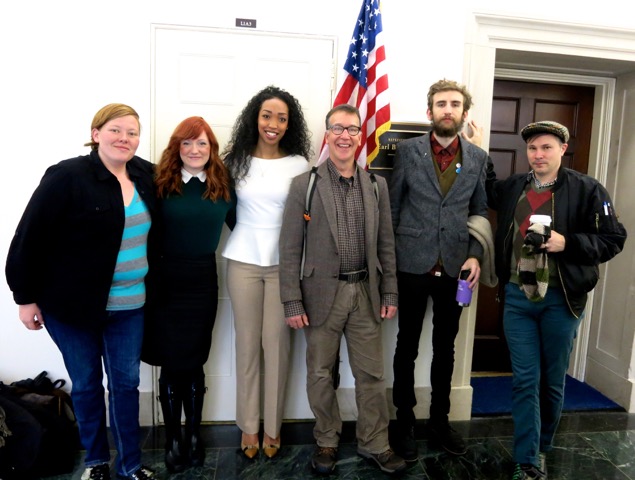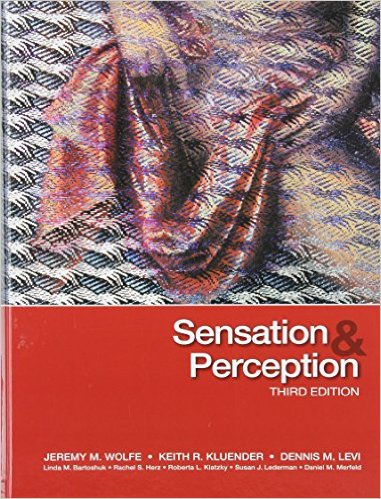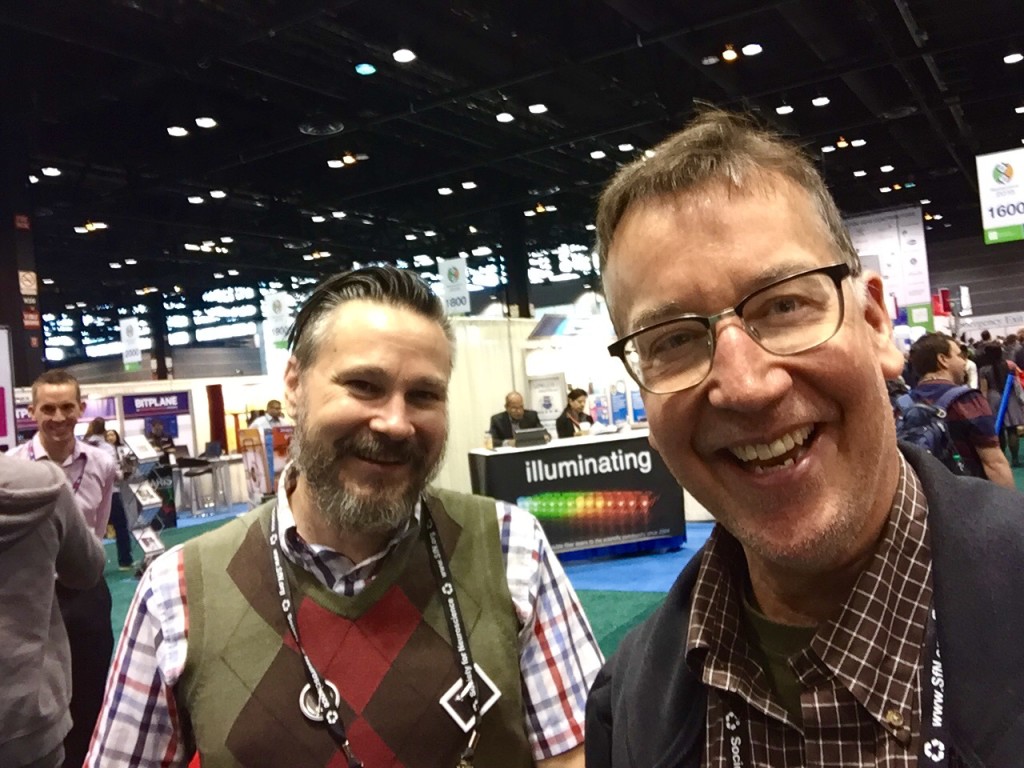Our well-traveled pipe cleaner neuron took a busy tour of SfN this weekend, thanks to travel support from the Vancouver branch campus of WSU, and drew in many curious conference attendees…
We began with a special Brain Awareness poster session on Saturday, devoted to “Sparking Connections Through Brain Awareness Around the Globe…”
Steven Hyman, the President of SfN, introduced the event, which honored, among others, the winner of the annual Brain Awareness Video Contest…
Matthew Sugrim from the UK created an accessible, entertaining video explaining how the brain processes vision, a subject much on our minds these days at nwnoggin.org…
Bobby Heagerty from the OHSU Brain Institute was the Brain Awareness event’s keynote speaker, and the room was packed with posters and presenters detailing creative outreach efforts from all over the world…
Including ours! Again, our neuron was quite a draw. People took “neuron selfies,” and were excited about bringing packs of pipe cleaners, and other brain-related art projects, to their own classrooms and public events…
We were a little stunned to discover that several attendees, including Meghan Mott and Samantha White from the National Institute of Neurological Disorders and Stroke (NINDS), had actually heard of NW Noggin (!), and our outreach activities in Portland and Vancouver, and were very interested in replicating our model in their own region (MD/DCnoggin..?)..!
After this event we met with Bobby, briefly, and then gladly tagged along with her to another special session devoted to political advocacy on behalf of NIH funding for outreach, education and research…
The keynote speaker was Congresswoman Jan Schakowsky, a member of the Congressional Neuroscience Caucus, which is co-chaired by two legislators from the Pacific Northwest: Oregon’s Earl Blumenauer, and Washington’s Cathy McMorris Rogers.
The Congresswoman spoke passionately about how lobbying can be effective, especially if people take the time to call congressional offices, or write letters and emails – she noted that it often does not take that many calls, or emails, to get something on the agenda…
After her speech, we introduced ourselves to the Congresswoman, briefly described NW Noggin, and noted that we’d already brought along several undergraduate outreach volunteers from PSU, and WSU Vancouver, to Congressman Blumenauer’s office last fall during the SfN conference in DC, to discuss our outreach activities, and lobby for more federal support for education and research.
We offered to bring our enthusiastic undergraduates, graduates, perhaps a few motivated K-12 students, our pipe cleaner neurons (which the Congresswoman had noticed :), and some real human brains to Capitol Hill, if it might help raise awareness of the importance of understanding how brains work, and how research, education and outreach in this area is critical for addressing national priorities, including issues of mental health, drug dependence, dementia, adolescent brain development, and healthy aging. She seemed intrigued…
On Sunday we were up early, fueled by Intelligentsia coffee, and made the public transit trek back to McCormick Place to hang our colorful poster by 8:00am…
We were joined by several graduate students from the Neuroscience department at WSU Vancouver (which is supporting our own participation at SfN), including Megan Slaker, Jonas Calsbeek, and Ram Kandasamy…
Our Noggin poster was very popular, and we lost our voices during that 8am – noon session, as multiple passers-by were drawn in again by that plush, compelling neuron…
We also dropped by the SfN table, where our Noggin stickers were becoming popular additions to conference badges…
We then explored the growing cadre of art and neuroscience exhibitions at SfN, including the gorgeous neuron-inspired metal and gem work of H. Kathleen Childress, the intriguing lighted sculptures and prints of Audrius V. Plioplys, and the striking Cajal-inspired etchings and scrolls of Greg Dunn.
We also admired the extraordinary textiles of Lia Cook, an artist with works in the DeYoung Museum in San Francisco – and also on the cover of the textbook we use in our Perception and Art & Brain classes at PSU and WSU Vancouver!
Lia is very interested in the role of touch in emotional experience and expression, and has worked with neuroscience researchers to examine the emotional impact of textiles, versus photographs…
We continued to explore exhibits, and introduce ourselves and our outreach efforts to representatives from AAAS, NIH, NSF, and other organizations. We also accumulated the typical conference bagfuls of pens, literature, and t-shirts…
We finally found time to attend our first nanosymposium, which offered almost three hours of individual 15 minute presentations on the cortical representation of visual scenes. This proved a particularly relevant topic, given our interest in perception, and how artists successfully convey visual aspects of landscapes and scenes through their work…
There was lots of cutting edge research data on the role of specific cortical regions in processing distinct aspects of visual space, including a region known as the parahippocampal place area, or PPA. We were particularly struck by attempts to identify “higher order” functional networks, including research from Christopher Baldassano at Princeton, who presented resting state functional connectivity data indicating two separate cortical networks, one very dependent on mapped retinal inputs, that maintains the current view of a scene, and another that adds context and semantic knowledge to what is being viewed…
All in all, a busy, terrific, informative, educational weekend at SfN. We headed out (with our popular neuron) to celebrate – and we plan to return for more lectures and symposia through Tuesday…






























